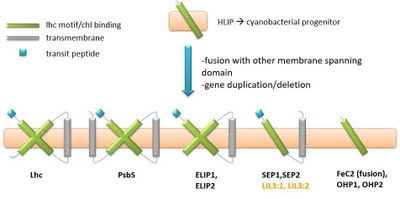Small LHC-like proteins and their impact on chlorophyll biosynthesis and assembly of photosynthesis protein complexes
The superfamily of LHC (light-harvesting complex) proteins not only includes the well-known, eponymous LHC proteins, but also smaller relatives. In resemblance to the structural properties of LHC proteins, these proteins possess one or two membrane-spanning α-helices, one of which is designated as a conserved chlorophyll-binding motif. Our objectives are to unravel the biological functions of the smaller light-harvesting like (LIL) proteins.
We are working in Arabidopsis thaliana on the two Lil3-isoforms (light-harvesting-like 3), as well as the two OHPs (one-helix proteins), which are the smallest members of the LHC superfamily.

Schematic drawing of the topology of proteins from the LHC superfamily. LHC proteins and ELIPs (early light-induced proteins) consist of three helices, two of them carrying the LHC-motif. Lil3-proteins possess two helices and OHPs one helix. It is assumed that the LHC protein family emerged from one-helix cyanobacterial progenitors via gene fusion and gene duplication events (Scheme prepared by Maxi Rothbart).
